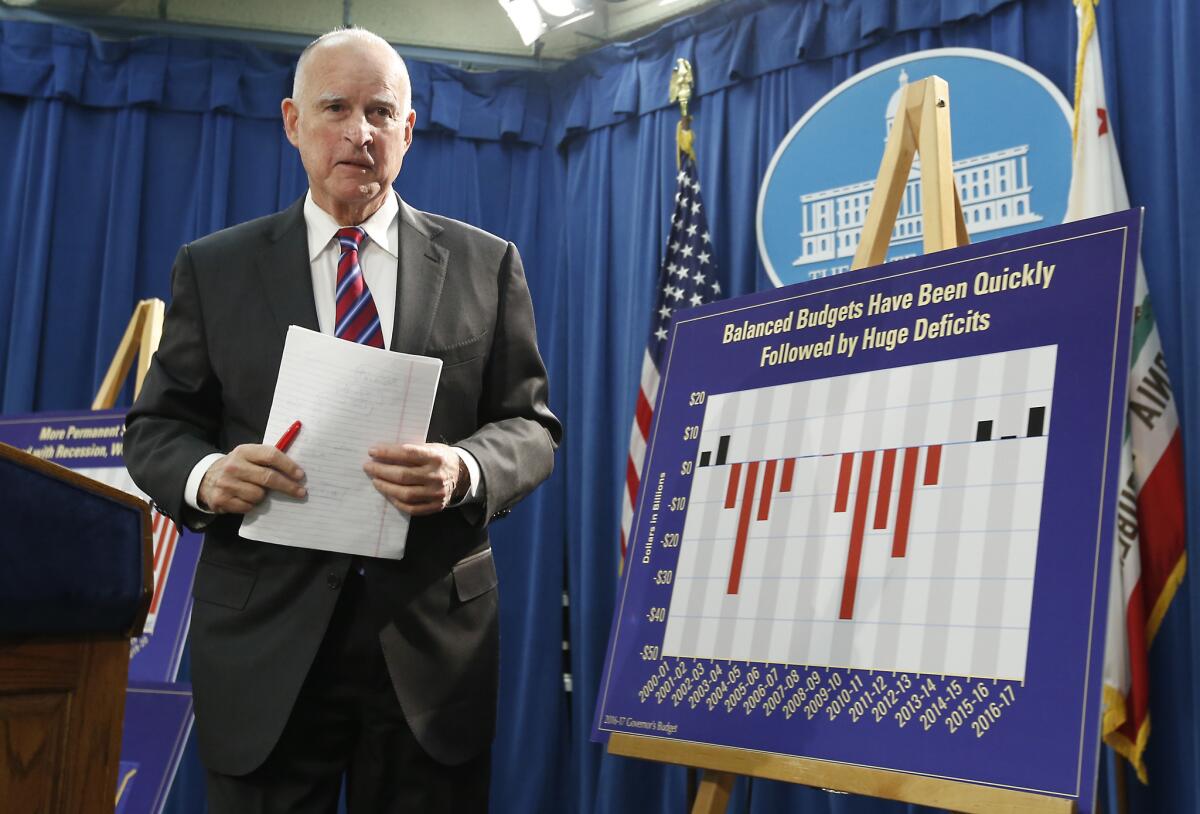Brown’s budget dominance starts with firm grip on revenue forecasts

Gov. Jerry Brown leaves a news conference where he unveiled his proposed 2016-17 state budget.
- Share via
Reporting From Sacramento — It was during a boisterous and brusque budget presentation when Gov. Jerry Brown offered a candid assessment of why he’s unwilling to grant too many legislative spending requests.
“There will be a tendency just to do everything, and then I’ll have to straighten it out at the end,” he said when releasing his $170.7 billion plan Thursday.
To avoid that, Brown deftly uses the single most powerful budget-writing tool at his disposal: the official forecast of tax revenues, the foundation on which all spending plans are built. Lower the forecasts, say budget watchers, and you neutralize most every request to expand government services.
“We’ve been concerned that this hasn’t received enough attention in the last few years,” said Chris Hoene, executive director of the California Budget and Policy Center, a nonprofit that advocates for programs to help the working poor.
Even the best state budgets include revenue estimates that are the product of mixing precise data with old-fashioned gut instinct. Economic forecasting, it’s said, is more art than science.
It can also have a dash of politics.
Governors routinely have different budget roadmaps than legislators. Brown has made it clear that his begins with a heavy bias towards caution.
“He figures that if he’s conservative going in, that gives him resources to work with the following year,” said Fred Silva, a budget analyst with the bipartisan think thank California Forward.
The question though, is do legislators agree with the governor’s revenue predictions? Recent history suggests the answer is no.
Over the past three years, the Legislature’s budget experts have predicted tax revenues would come in at higher levels than Brown assumed. When the final numbers were tallied, the legislative analysts have been more accurate.
And yet each year, enacted budgets used the lower revenues from the governor.
A review of the last five spending plans shows no year has seen more than a tiny two-tenths of a percent gap between Brown’s revenue estimates and the numbers ultimately written into law. Last year, the gap was zero: legislators gave Brown a budget that completely abandoned their own revenue estimates.
When it comes to predicting tax revenues, they say, the governor simply doesn’t negotiate.
“He has been very insistent,” said state Sen. Mark Leno (D-San Francisco).
The practical impact of Brown’s no-haggle stance is fewer available dollars for social services programs favored by liberal Democrats. Critics accuse Brown of doing too little to restore safety net programs still funded at levels below where they were when the recession hit in 2008.
“It’s sort of galling,” said Hoene, “that people who took cuts during the recession are still being told, ‘No, the state can’t afford it.’”
That’s where the veteran governor’s skill comes in creating a compelling public narrative. Each time his revenue estimates have proved too modest, Brown has insisted that the additional dollars be stashed away or spent on one-time things like debt. He has successfully branded those dollars not as a trend but rather an anomaly.
“We’re talking about the most experienced governor,” said Leno, the longtime chairman of the Senate’s budget committee. “He knows how to use the powers that the Constitution afford him, and uses them well.”
The horse trading between governors and legislators on revenues and spending reached its peak during the years when Brown was away from the state Capitol. Legislative leaders and governors would routinely craft numbers that reflected a more balanced era of political power.
In several instances during the administrations of former Govs. Pete Wilson and Gray Davis, budgets were signed with $1 billion to $2 billion or more added to the official revenue predictions.
Those kinds of negotiations all but ended with Brown’s arrival in 2011.
The governor insists he’s simply being a good steward of taxpayer money.
“Most every program you’re going to hear about in the next nine months will be good and will help people,” he said on Thursday, anticipating renewed criticism of his relatively tight-fisted budget approach.
It’s an approach that has garnered national attention, also one that may have failed but for the governor’s dominance over revenue estimates. His firm grip on that single lever of power has ended the annual budget battle before the first shots are ever fired.
“It’s wonky and it’s technical,” Hoene said. “But the biggest decision is being made right out of the gates, and a lot of people are being left behind.”
Follow @johnmyers on Twitter and sign up for our daily Essential Politics newsletter
ALSO:
Brown again preaches prudence in state budget
Budget reflects Brown is sour on ballot initiatives
Brown’s budget earmarks big money for natural disasters
Follow along with live updates from Sacramento
More to Read
Get the L.A. Times Politics newsletter
Deeply reported insights into legislation, politics and policy from Sacramento, Washington and beyond. In your inbox twice per week.
You may occasionally receive promotional content from the Los Angeles Times.











